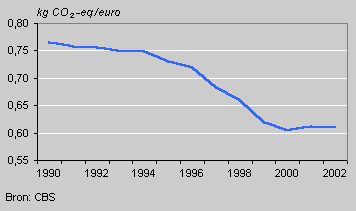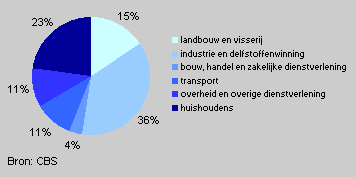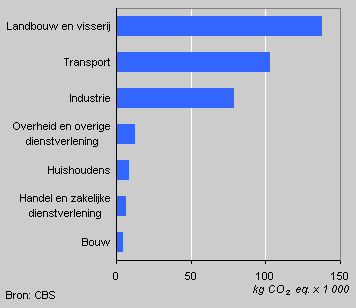Economy stagnates, emission of greenhouse gases still stable

The emission of greenhouse gases increased steadily in the period 1990-2002. This increase (5 percent) is much smaller than economic growth in this period (35 percent).
Emission of greenhouse gases and value added
The emission of greenhouse gases per euro of value added decreased substantially in the period 1994-1999. This stopped in 2000. The volume growth of value added has stagnated since 2000, while the emission of greenhouse gases continued to increase slightly. This means there is no longer a separation between economic growth and the emission of greenhouse gases.
Emission of greenhouse gases per euro of value added, 1995 prices

One third of greenhouse gases from manufacturing
The manufacturing and mineral extraction sectors account for nearly one third of the emission of greenhouse gases in the Netherlands. Households, which account for one quarter of all emissions, produce greenhouse gases when they use natural gas and petrol.
In the period 1990-2002 the largest increase in emission was for waste incineration, which pushed up the increase in environmental services by 73 percent. The increase in the transport sector was 37 percent.
In agriculture the emission of greenhouse gases decreased by 9 percent, however.
Greenhouse gas emissions by economic activity, 2002

Emission per worker: high in agriculture and transport
In terms of workers per sector, emission was highest in agriculture and transport. In agriculture it was 138 thousand kg per worker, because of large amounts of methane and laughing gas which are released in cattle farming.
In the transport sector the emission was 103 thousand kg per worker. There are considerable differences within this sector: 52, 581 and 427 thousand kg per worker for transport by land, water and air respectively.
Average emission of greenhouse gases per worker by economic activity, 2002

Sjoerd Schenau
Source: National accounts